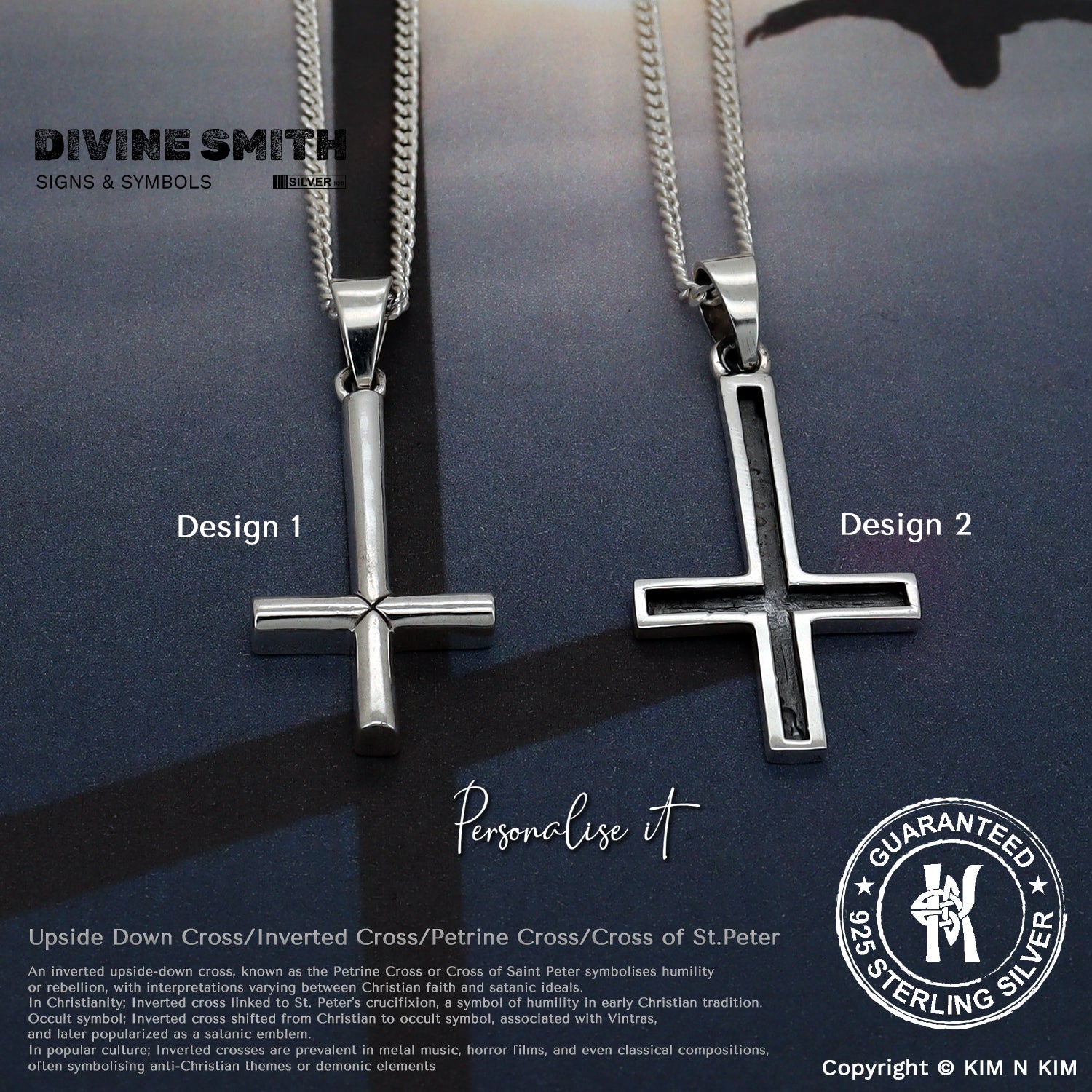Cross Of Peter: A Deep Dive Into Its History, Symbolism, And Cultural Relevance
**Ever wondered what the Cross of Peter is and why it holds so much significance? This upside-down cross has more depth than just its unique orientation. It's not just a religious symbol; it's a story of humility, sacrifice, and faith. Today, we're going to unravel its mysteries and explore why it continues to resonate with people worldwide. So, buckle up, because we're diving deep into the world of the Cross of Peter.**
Before we dive headfirst into the nitty-gritty, let's talk about why this topic matters. The Cross of Peter, also known as the Petrine Cross, is a symbol that transcends religion and speaks to universal values. It's not just for those who follow Christianity; it's for anyone who appreciates the power of humility and the importance of standing by your beliefs, no matter the circumstances.
Now, if you're here, chances are you're curious about its origins, its symbolism, and how it fits into modern culture. That's exactly what we're going to cover in this article. So, whether you're a history buff, a religious scholar, or just someone looking to expand their knowledge, you're in the right place. Let's get started!
Read also:450 Lakeville Road Cancer Center A Beacon Of Hope In Modern Healthcare
What Is the Cross of Peter?
The Cross of Peter, or the Petrine Cross, is an inverted cross that holds deep religious and historical significance. Unlike the traditional cross, which represents Christ's crucifixion, the Cross of Peter symbolizes St. Peter's martyrdom. Legend has it that Peter, one of Jesus' apostles, felt unworthy to be crucified in the same manner as his Lord, so he requested to be crucified upside down. This act of humility is what the Cross of Peter represents.
But why does this matter? Well, in a world where pride often takes center stage, the Cross of Peter serves as a reminder that true strength lies in humility. It's a symbol that encourages us to embrace our imperfections and to serve others selflessly. And in today's fast-paced world, where values can sometimes get lost in the shuffle, the Cross of Peter offers a timeless lesson that's as relevant today as it was centuries ago.
Origins and Historical Context
Early Beginnings
The origins of the Cross of Peter can be traced back to the early days of Christianity. According to tradition, St. Peter was martyred in Rome during the reign of Emperor Nero. Peter, who was one of the most prominent apostles, chose to be crucified upside down out of humility. This act of selflessness became a cornerstone of Christian teachings and inspired countless followers throughout history.
Interestingly, the Cross of Peter wasn't widely used as a symbol until much later. In fact, it wasn't until the Middle Ages that it began to gain popularity. During this time, the cross became a powerful emblem of faith and a reminder of the sacrifices made by early Christians.
Symbolism Through the Ages
Over the centuries, the Cross of Peter has taken on various meanings. For some, it represents the ultimate act of humility. For others, it's a symbol of courage and resilience. Whatever the interpretation, one thing is clear: the Cross of Peter continues to inspire people across the globe.
But what makes this symbol so enduring? Part of its appeal lies in its simplicity. An inverted cross may seem like a small detail, but it carries a profound message. It reminds us that true greatness often comes from serving others and putting their needs before our own.
Read also:How To Ace Your Costco Employment Application Online Your Ultimate Guide
Religious Significance
Christianity's Perspective
In Christianity, the Cross of Peter is seen as a powerful reminder of the apostle's sacrifice. It symbolizes the importance of humility and the willingness to endure suffering for one's beliefs. Many Christians wear the Cross of Peter as a way to honor St. Peter and to remind themselves of the values he stood for.
But it's not just about wearing a symbol; it's about living out its message. The Cross of Peter challenges us to examine our own lives and to consider how we can serve others more effectively. In a world that often values ambition and success, the Cross of Peter offers a refreshing perspective on what truly matters.
Interpretations Beyond Christianity
While the Cross of Peter is deeply rooted in Christian tradition, its message resonates with people of all faiths. For some, it represents the universal value of humility. For others, it's a symbol of standing up for what you believe in, even when it's difficult.
One interesting point to note is that the Cross of Peter has been adopted by various cultures and communities around the world. Its universal appeal lies in its ability to transcend religious boundaries and speak to the shared human experience of sacrifice and service.
Cultural Impact
Influence on Art and Literature
The Cross of Peter has had a significant impact on art and literature throughout history. From paintings to poetry, this symbol has inspired countless works of creativity. Artists and writers have used the Cross of Peter to explore themes of humility, sacrifice, and faith.
- Paintings featuring the Cross of Peter often depict St. Peter's martyrdom, capturing the emotional intensity of the moment.
- Poets have written odes to the cross, using its imagery to convey deeper truths about the human condition.
- In literature, the Cross of Peter serves as a metaphor for the struggles and triumphs of everyday life.
Modern-Day Relevance
In today's world, the Cross of Peter continues to be a source of inspiration. Whether it's through jewelry, tattoos, or other forms of personal expression, people are finding new ways to connect with this ancient symbol. Its message of humility and service speaks to a generation that values authenticity and purpose.
Moreover, the Cross of Peter has found its way into popular culture, appearing in movies, TV shows, and even video games. Its presence in these mediums highlights its enduring relevance and its ability to resonate with diverse audiences.
Symbolic Meanings
Humility and Service
At its core, the Cross of Peter is a symbol of humility. It reminds us that true strength comes from serving others and putting their needs before our own. In a world that often celebrates individual achievement, the Cross of Peter offers a counter-narrative that emphasizes the importance of community and collaboration.
But humility isn't just about putting others first; it's also about recognizing our own limitations. The Cross of Peter encourages us to embrace our imperfections and to seek growth through service. It's a reminder that we're all on a journey, and that the path to greatness lies in helping others along the way.
Sacrifice and Resilience
Another key aspect of the Cross of Peter is its message of sacrifice and resilience. St. Peter's decision to be crucified upside down was an act of courage that continues to inspire people today. It shows us that standing up for our beliefs, even in the face of adversity, is one of the greatest acts of strength we can undertake.
Whether it's in our personal lives or in the broader context of society, the Cross of Peter reminds us that true change often requires sacrifice. It challenges us to consider what we're willing to give up in order to make a difference in the world.
Contemporary Uses
Jewelry and Fashion
One of the most popular ways people connect with the Cross of Peter is through jewelry and fashion. From necklaces to bracelets, the cross has become a staple in modern accessories. Its unique design and deep symbolism make it a favorite among those who appreciate meaningful jewelry.
But it's not just about looks; it's about the message behind the symbol. Many people choose to wear the Cross of Peter as a daily reminder of the values it represents. Whether it's a small pendant or a bold statement piece, the cross serves as a powerful talisman for those who believe in its message.
Tattoos and Body Art
In recent years, the Cross of Peter has gained popularity as a tattoo design. Its distinctive shape and rich history make it a popular choice for those looking to express their faith or personal values. Whether it's a simple line drawing or a complex piece of art, the cross tattoo offers a permanent reminder of the lessons it teaches.
For some, getting a Cross of Peter tattoo is a way to honor St. Peter and the sacrifices he made. For others, it's a personal symbol of resilience and strength. Whatever the reason, the cross tattoo continues to be a powerful form of self-expression.
FAQs About the Cross of Peter
Why Is the Cross Upside Down?
The Cross of Peter is upside down because St. Peter requested to be crucified in this manner. He felt unworthy to die in the same way as Jesus, so he chose to be crucified upside down as an act of humility. This decision has made the inverted cross a powerful symbol of selflessness and sacrifice.
Who Can Wear the Cross of Peter?
Anyone can wear the Cross of Peter, regardless of their religious beliefs. While it holds deep significance for Christians, its message of humility and service resonates with people of all faiths. Whether you're wearing it as a fashion statement or as a symbol of your values, the Cross of Peter offers a meaningful way to connect with its message.
Is the Cross of Peter Only for Religious People?
Not at all! While the Cross of Peter has its roots in Christianity, its message transcends religious boundaries. It speaks to universal values like humility, sacrifice, and resilience, making it relevant to anyone who appreciates these qualities.
Conclusion
In conclusion, the Cross of Peter is more than just a religious symbol; it's a powerful reminder of the values that matter most. From its origins in early Christianity to its modern-day relevance, the cross continues to inspire people around the world. Its message of humility, sacrifice, and service offers a timeless lesson that's as important today as it was centuries ago.
So, whether you're wearing the Cross of Peter as a piece of jewelry, getting it as a tattoo, or simply appreciating its symbolism, remember the lessons it teaches. Embrace humility, serve others selflessly, and stand firm in your beliefs. And if you found this article helpful, don't forget to share it with your friends and family. Together, let's keep the message of the Cross of Peter alive and thriving!
Table of Contents
- What Is the Cross of Peter?
- Origins and Historical Context
- Religious Significance
- Cultural Impact
- Symbolic Meanings
- Contemporary Uses
- FAQs About the Cross of Peter
- Conclusion


